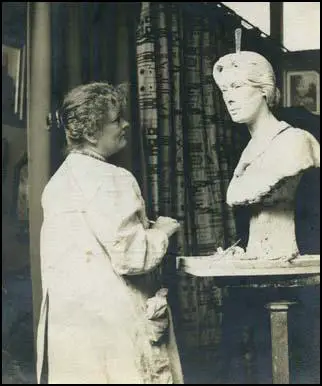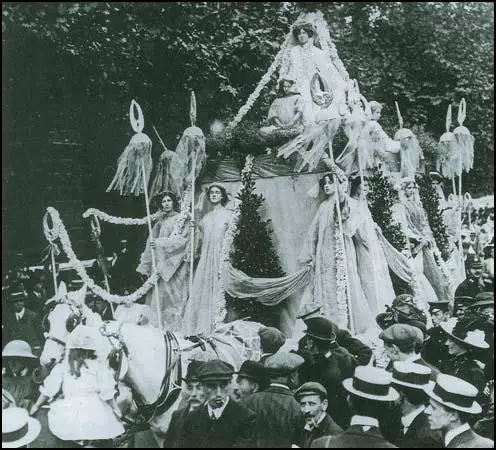Edith Downing
Edith Downing was born in Cardiff in 1857. She studied at the Slade School of Fine Art (1892-93) and exhibited at the Royal Academy for the first time in 1892. In 1898 she had two sculptures accepted. Over the next few years she became a regular exhibitor at the academy.

Downing joined the Central Society for Women's Suffrage in 1903 and its successor, London Society for Women's Suffrage in 1906. Downing became frustrated by the lack of success of these organisations and in 1908 she became a member of the Women Social & Political Union. The following year she made small portraits of Christabel Pankhurst and Annie Kenney, that were sold for WSPU funds.
Downing joined forces with Marion Wallace-Dunlop to organise a series of spectacular WSPU processions. The most impressive of these was the Woman's Coronation Procession on 17th June 1911. Flora Drummond led off on horseback with Charlotte Marsh as colour-bearer on foot behind her. She was followed by Marjorie Annan Bryce in armour as Joan of Arc.
The art historian, Lisa Tickner, described the event in her book The Spectacle of Women (1987): "The whole procession gathered itself up and swung along Northumberland Avenue to the strains of Ethel Smyth's March of the Women... The mobilisation of 700 prisoners (or their proxies) dressed in white, with pennons fluttering from their glittering lances, was, as the Daily Mail observed, "a stroke of genius". As The Daily News reported: "Those who dominate the movement have a sense of the dramatic. They know that whereas the sight of one woman struggling with policemen is either comic or miserably pathetic, the imprisonment of dozens is a splendid advertisement."

During the 1910 General Election the NUWSS organised the signing petitions in 290 constituencies. They managed to obtain 280,000 signatures and this was presented to the House of Commons in March 1910. With the support of 36 MPs a new suffrage bill was discussed in Parliament. The WSPU suspended all militant activities and on 23rd July they joined forces with the NUWSS to hold a grand rally in London. When the House of Commons refused to pass the new suffrage bill, the WSPU broke its truce on what became known as Black Friday on 18th November, 1910, when its members clashed with the police in Parliament Square. Edith Downing was one of the women arrested during this demonstration but was released without charge. On 23rd November she was arrested again and sentenced to seven days' imprisonment for throwing a stone through a window of Somerset House.
Christabel Pankhurst decided that the WSPU needed to intensify its window-breaking campaign. On 1st March, 1912, a group of suffragettes volunteered to take action in the West End of London. The Daily Graphic reported the following day: "The West End of London last night was the scene of an unexampled outrage on the part of militant suffragists.... Bands of women paraded Regent Street, Piccadilly, the Strand, Oxford Street and Bond Street, smashing windows with stones and hammers." Edith Downing was arrested for taking part in this demonstration. While in Holloway Prison she took part in the mass hunger strike and was forcibly fed before being released.
Edith Downing, who lived with Ellen Sparks for the last twenty-five years of her life, died in Peaslake, Surrey aged 75 on 3rd October 1931.

